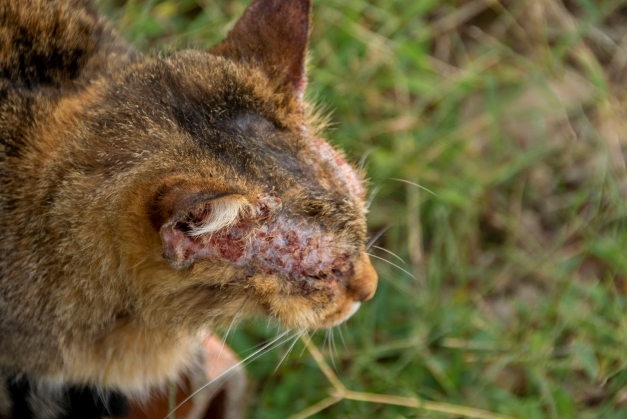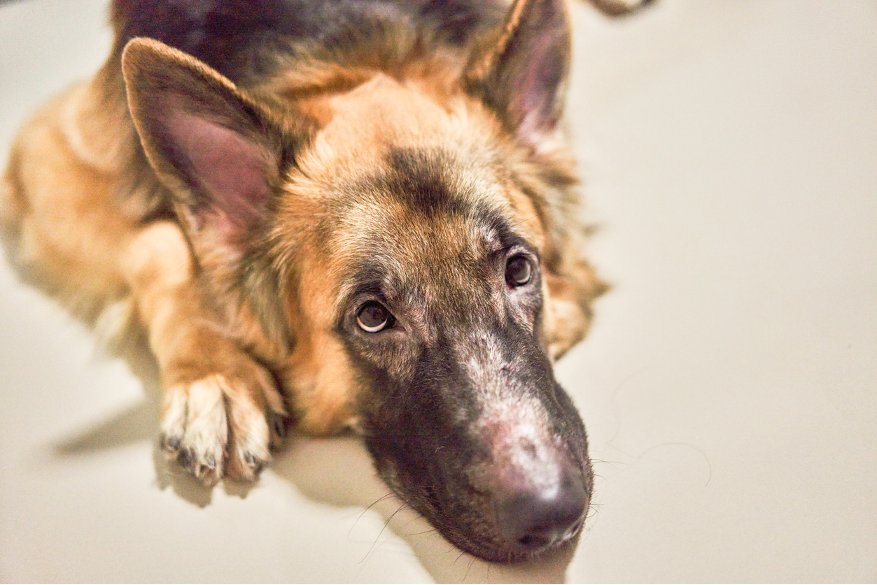Does your dog smell like your gym sneakers? Is your cat balding? If so, you may have a problem. While canines have a distinct smell, an exceptionally odorous dog may have an underlying health condition. It’s natural for your cat to groom herself but pulling out hair is a cause for concern. If you have a pet that smells like stinky feet or has scabbing, patchy, or dull fur, you should bring them in to be evaluated by a veterinarian.
Possible Signs of Skin or Ear Infection
The above symptoms are common signs of a skin or ear infection. In severe skin and ear infections the patient may be lethargic or have swollen lymph nodes. An infection can cause the pet to feel very poorly. While routinely bathing your pet to remove dirt and allergens from the surface of the skin is helpful, patients may need more extensive treatment.
Getting to the Root Cause of Your Pet’s Skin Problem
To determine the cause of the skin infection, the doctor will take a swab of the dog’s skin. The swab will be stained and evaluated underneath a microscope to determine the type of treatment necessary. The first step is often treating any canine skin infection with an antibiotic or anti-fungal. We prescribe products like Apoquel to help control the itch.

Although many cats are kept inside, they are not immune to skin problems. For example, cats can contract mange or ringworm. And many cats are very sensitive to flea bites. But cat owners will not always see evidence of fleas. Cats meticulously groom themselves, often eating the fleas, which can cause a patchy coat or barbed fur.
Dealing with Itchy or Inflamed Ears
A pet with itchy, inflamed ears will also need topical treatment. The veterinarian will swab the cat or dog’s ears to determine the presence of microorganisms or mites. Then the veterinarian will prescribe a treatment based on the microorganisms found. The veterinarian may do a long-acting treatment in the clinic. They may also prescribe a treatment for you to do at home. In this case, the owner will do daily cleanings and instill ointment into the patient’s ears.
Although occasionally we may find ear mites in a dog, we see most ear mites in cats. Cats with ear mites receive a one-time treatment for ear mites at the clinic. If you have a multi-cat household, all cats in the home should be treated at once as the cats can transfer ear mites to each other through direct contact. Cats with severe ear mite infections may also develop an ear infection after the mites die. These cats will need additional treatment for the microorganisms growing in the debris left from the dead mites.
Although all pets may develop an ear infection, hot spot, or lick their feet occasionally, patients who routinely have these problems may need additional diagnostics to find the root cause.
Signs of Possible Thyroid Problems
Some patients may be struggling with their thyroid function. Hypothyroidism, or an underactive thyroid, affects dogs causing weight gain, darkened skin, or a thinning, dull hair coat. Hypothyroid dogs have weakened skin barriers allowing allergens and infections easier entry. Hyperthyroidism, or an over-active thyroid, affects cats causing weight loss or an uneven, matted, greasy fur coat.
Food or Environmental Allergies
Other patients may be suffering from food or environmental allergies. Our clinic offers Nextmune testing and treatment for allergies. Check out the frequently asked questions about allergens, allergic symptoms, and testing through Nextmune.
Final Words
We understand that it can be extremely frustrating to have a pet with a skin condition. But finding the root cause and watching the patient become happy and energetic again can be equally rewarding.
